This report is the first to propose a definition of financing for food security and nutrition. This definition is grounded in a conceptual understanding of the definition and determinants of food security and nutrition, the interconnected nature of food security and nutrition, and the major drivers behind recent setbacks in achieving an end to hunger, food insecurity and all forms of malnutrition.
The different financing flows to food security and nutrition
Financing is the process of providing funds for the public and private sector to engage in economic activities, make purchases or carry out investments. The funds may or may not be provided conditional on a certain return (interests, dividends and so on) or reimbursement (of debt principal). Financial resources may be provided by one or a combination of four sources: i) public domestic, ii) public foreign, iii) private domestic, and iv) private foreign. Each source may provide financing through a range of financial instruments to finance short-term and long-term interventions on commercial or concessional terms (e.g. grants or loans below market rates).
Table 8 shows examples of different financing flows that belong exclusively to each source of financing. There are other financing flows that are common to more than one source of financing; for example, remittances can be private domestic or private foreign. On the other hand, commercial and non-commercial financing flows can come from all four sources of financing. For the purposes of simplicity, financing flows that are common to more than one category are not identified in Table 8 but are further elaborated in the text below and in Chapter 5. See Box 6 for a short definition of financial terminology, and Annex 2 Glossary for more elaborated definitions of key financial terms used in this report.
TABLE 8Matrix of different financing flows by source

SOURCE: Authors’ (FAO) own elaboration.
BOX 6Brief definition of the financial terms used in this report
Blended finance. The strategic use of development or concessional finance for the mobilization of additional finance, usually commercial private finance, towards sustainable development.
Capital markets. A subset of financial markets that specifically deal with the buying and selling of equity and debt securities, primarily.
Commercial finance. Commercial refers to activities of commerce business operations to earn profits. Non-commercial activities can be conducted by non-profit organizations or government agencies.
Debt. A debt arrangement gives the borrowing party permission to borrow money on condition that it must pay back the sum later, usually with interest.
Domestic private investment. A measure of the amount of money that domestic businesses invest within their own country. It can be represented with the accounting equation: non-residential investment + residential investment + change in inventories.
Equity. Ownership stake in an asset minus the amount of all liabilities on that asset.
Export credits. Financing or credit facilities that are extended to exporters to enable them to sell goods and services in overseas markets.
Financing. The process of providing funds for the public and the private sector to engage in economic activities, make purchases or carry out investment. The funds may or may not be provided conditional on a certain return (interests, dividends and so on) and/or reimbursement (of debt principal).
Foreign direct investment (FDI). A type of investment made by a private entity resident in one economy in an enterprise resident in another.
Funding. In the strictest sense, the provision of funds without requirement of return or reimbursement. In a broad sense, any provision of funds, similar to financing, which may or may not involve an expectation of return or repayment.
Insurance. A contract, represented by a policy, in which a policyholder receives financial protection or reimbursement against the probable occurrence of losses from an insurance company.
International portfolio investment. A type of investment that consists of securities and other financial assets held by investors in another country.
Investment. The commitment of current financial resources to achieve higher gains in the future.
Official development assistance (ODA). Government aid designed to promote the economic development and welfare of developing countries that meet a minimum grant element requirement.
Other official flows (OOF). Official sector transactions that do not meet ODA criteria, either because they are not primarily aimed at development or because they do not meet the minimum grant element requirement.
Private financing. The process of obtaining or raising funds by private sector entities to support various activities or investments.
Private domestic financing. The process of obtaining funds from domestic or national private investors and lenders.
Private foreign financing. The process of obtaining funds from foreign or international private investors and lenders.
Public financing. The process of obtaining or raising funds by public sector entities (domestic and foreign governments, international organizations).
Public domestic financing. The process through which governments raise and allocate funds to finance public expenditures, mostly through taxes and loans.
Public foreign financing. The process through which governments raise, allocate and spend their own funds to support various activities or investment in other countries.
Remittances. Private, voluntary monetary and non-monetary (social or in-kind) transfers made by migrants and diaspora, individually or collectively, to people or to communities not necessarily in their areas of origin. They can be cross-border or in the home country.
Security. A fungible, negotiable financial instrument that represents some type of financial value, usually in the form of a stock, bond or option.
Public financing consists of flows financed out of public sources, the largest of which are taxes and borrowing (domestic and foreign) that governments use to fund expenditures. Social contributions, grants, property income, sales of goods and services, and other miscellaneous revenues (such as fees and sales of natural resources) are other sources of revenue, but they are much smaller for most countries.15, 16
Public domestic financing is the process through which governments raise, allocate and spend their own funds to finance public expenditures, mostly through taxes and loans.
Public resources can also consist of public foreign financing, for example, ODA and other official flows (OOF). Official development assistance refers to official financial transactions by the official sector within countries and territories that meet the requirement of a minimum grant element. It can include humanitarian finance, multilateral development banks, and blended finance, the latter of which uses public money to crowd in private finance. Other official flows are transactions by the official sector with countries and territories that do not meet the conditions for eligibility for ODA, either because they are not primarily aimed at development or because they do not meet the minimum grant element requirement.17, 18
Private financing, on the other hand, consists of flows at market terms financed by private sector resources and private grants. It can include both foreign and domestic financing. For example, private sector spending on research and development investments or farmers’ and processors’ investments in diverse and nutritious crops and foods, such as orange-fleshed sweet potato or legumes rather than wheat or maize, can be considered investments in nutrition.
Private domestic financing consists of domestic private investment usually owned by domestic or local private investors.19 Private domestic financing includes loans and other financial instruments (including project finance) from banks as well as investment and risk-management instruments from capital markets, and private philanthropic institutions whose funding represents aid rather than for-profit activities. Private commercial sector investments and financing to global and national agrifood systems are sizeable, largely driven by commercial actors. However, investments by farmers and processors in crops and foods more generally are considered investments in food security. Investments in capital stock by farmers are a large share of private domestic finance.20
Private foreign financing consists of FDI and/or international portfolio investment, both owned by foreign or international private investors.19 These can include private export credits, securities of multilateral agencies and bilateral portfolio investments. Private flows other than FDI are restricted to credits with a maturity of more than one year.18 Foreign direct investment can be inflows or outflows of capital from one country to another. It is an ownership stake in a foreign company or project made by an investor, company or government from another country. Remittances are also included here. In many developing countries, remittances are the largest foreign source of financing, greater than ODA and FDI.
A core and an extended definition of financing for food security and nutrition
The new definition of financing for food security and nutrition presented in this report comprises core and extended definitions. The core definition includes the financing flows that support efforts addressing the main determinants of food security and nutrition. The extended definition builds on this, to include financing flows that contribute to addressing the major drivers and underlying structural factors behind recent increases in food insecurity and malnutrition. These definitions are articulated into one in Box 7, conceptually summarized in Figure 15 and explained in detail in the sections below.
BOX 7The definition of financing for food security and nutrition
Financing for food security and nutrition refers to the process of providing or obtaining financial resources to ensure that all people, at all times, have stable, physical, social and economic access to sufficient, safe and nutritious food that meets their dietary needs and food preferences for an active and healthy life, and suitable food preparation and handling, feeding, caring, and health-seeking practices, and access to health, water and sanitation services to ensure a continued adequate nutritional status. Such financial resources may be provided by one or a combination of four sources of financing: i) public domestic, ii) public foreign, iii) private domestic, and iv) private foreign. Each of the different sources of financing deploys a range of financial instruments to finance short-term and long-term interventions on a commercial or concessionary basis (e.g. grants or loans below markets rates).
Financing for food security and nutrition therefore includes the financial resources that contribute to the eradication of hunger, food insecurity and malnutrition in all its forms across a rural–urban continuum.21 The resources are targeted to ensure the availability, access, utilization and stability of nutritious and safe food, practices that favour healthy diets, as well as health, education and social protection services that enable adequate nutritional status across the life course.
Additionally, it covers expenditures and investments that aim to ensure that all individuals are protected against short-term or long-term instability in food security and nutrition, caused by various climatic, economic, social, commercial and political factors. Financing therefore encompasses all the interventions aligned with the six transformative policy pathways designed to strengthen the resilience of agrifood systems to the major drivers behind hunger, food insecurity and malnutrition – namely conflicts, climate variability and extremes, and economic slowdowns and downturns – and address the underlying structural factors: lack of access to and unaffordability of nutritious foods and unhealthy food environments, and high and persistent inequality. That is, investments to: i) integrate humanitarian, development and peacebuilding policies in conflict-affected areas; ii) scale up climate resilience across agrifood systems; iii) strengthen the economic resilience of the most vulnerable to economic adversity; iv) intervene along agrifood supply chains to lower the cost of nutritious foods; v) shifting food environments towards healthier dietary patterns with positive impacts on human health; and vi) tackle structural inequalities, ensuring interventions are well targeted and inclusive. As such, investments in food security and nutrition span a wide variety of sectors. They can include investments in resilient and sustainable increases in agricultural productivity; water, sanitation and hygiene practices; conflict-sensitive policies; social protection; climate-smart agriculture; rural roads and infrastructure; healthy public food procurement; and access to essential health services.
The operationalization of this definition and mapping to sector-, purpose- and intervention-related keywords is provided in Section S3.2 of the Supplementary material to Chapter 3 in this report.
FIGURE 15 A conceptual diagram of the new definition of financing for food security and nutrition – for ending hunger and food insecurity (SDG Target 2.1) and all forms of malnutrition (SDG Target 2.2)
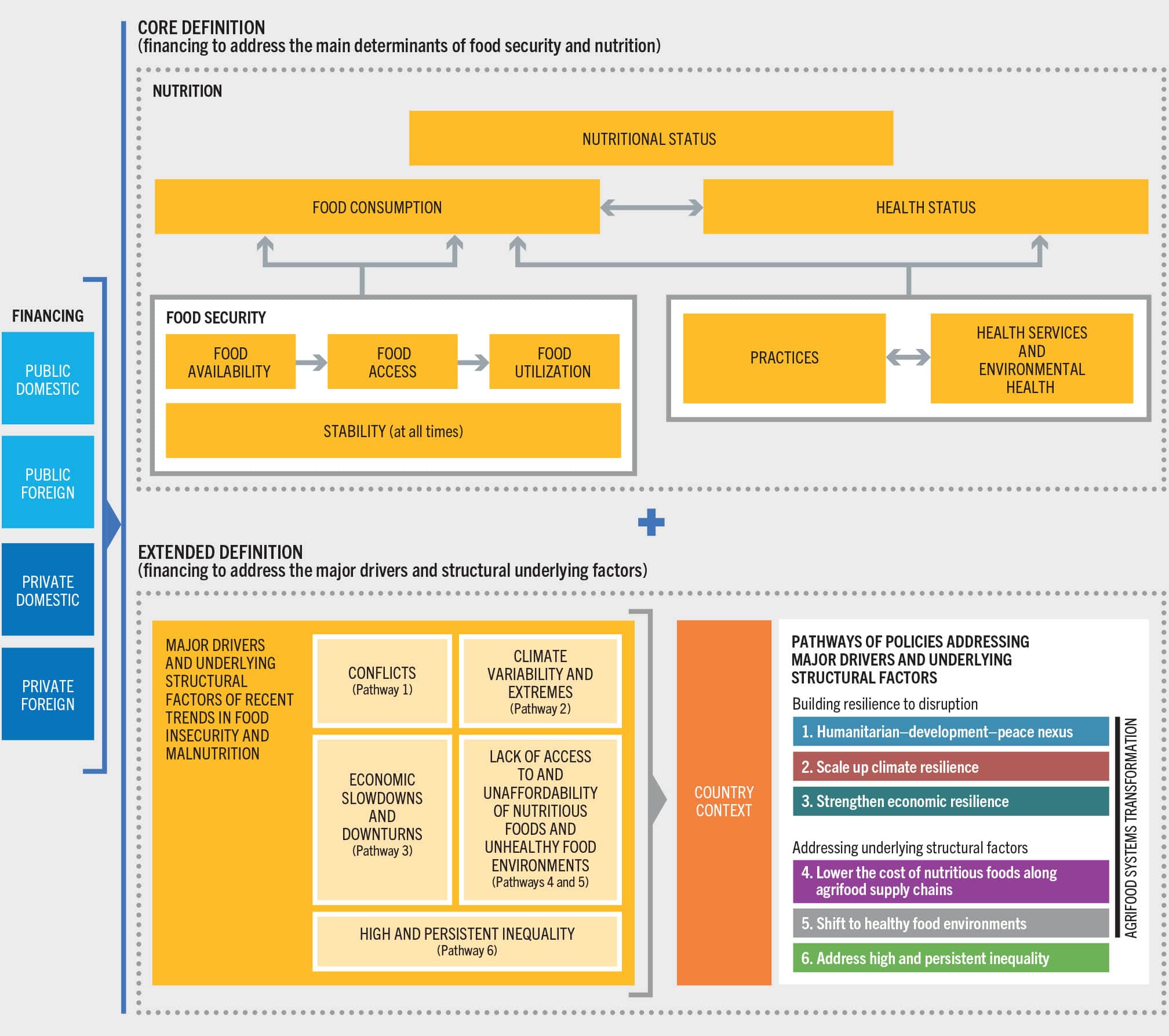
SOURCE: Authors’ (FAO) own elaboration.
A core definition – the lens on food security and nutrition dimensions and determinants
According to this report, food security is defined as “a situation that exists when all people, at all times, have physical, social and economic access to sufficient, safe and nutritious food that meets their dietary needs and food preferences for an active and healthy life” (see Annex 2 Glossary). Based on this definition, four food security dimensions can be identified: food availability, economic and physical access to food, food utilization, and stability over time (Figure 15 and Figure 16). Note that the concept of food security is evolving to recognize the centrality of agency and sustainability. However, these two dimensions are captured under the extended definition of financing for food security and nutrition.
FIGURE 16 The core definition of financing for food security and nutrition entails addressing the main determinants of food security and nutrition
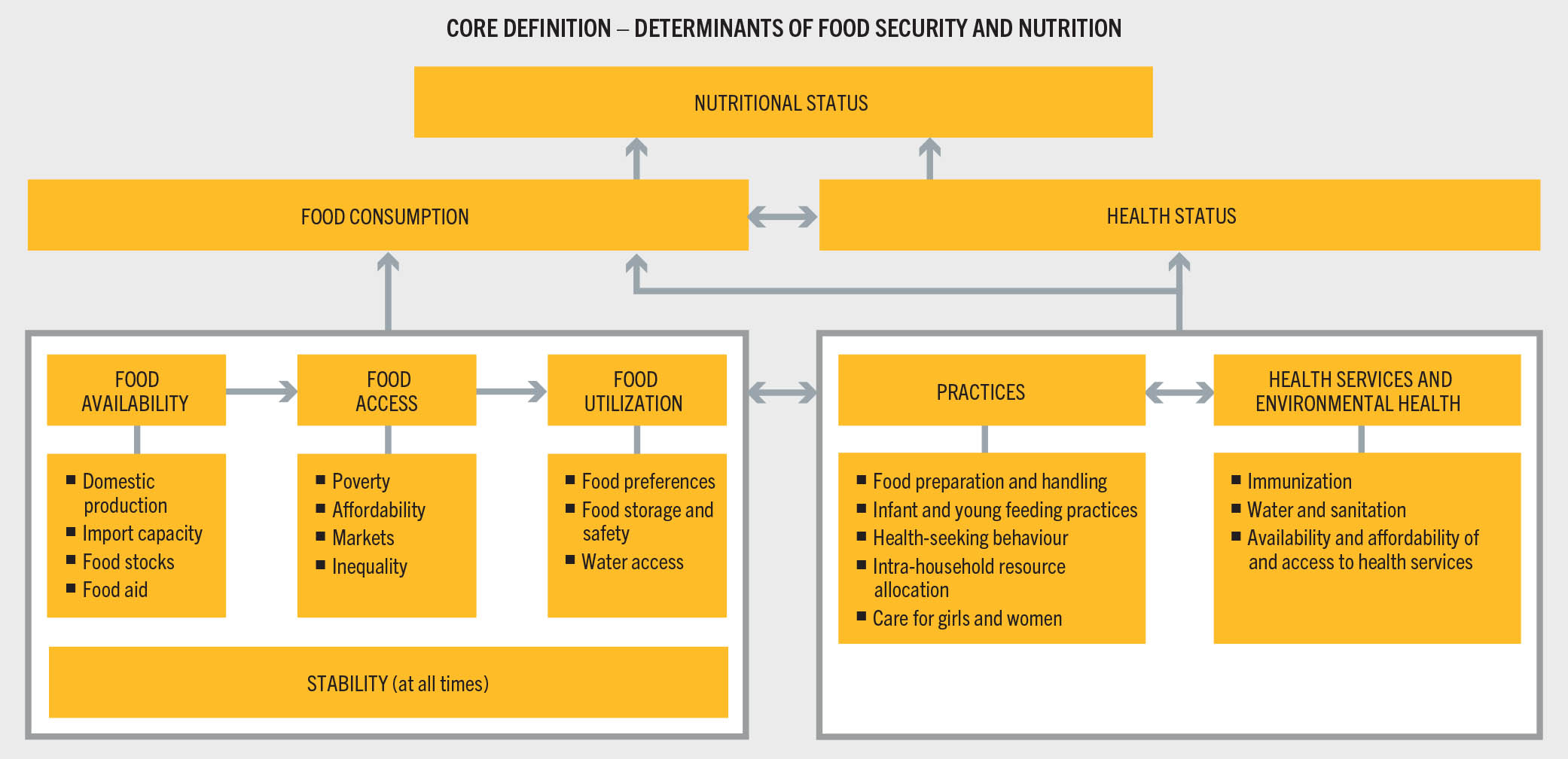
Defining the dimensions, food availability addresses whether or not safe and nutritious food is actually or potentially physically present, including aspects of production, food reserves, markets and transportation, and wild foods, while food access relates to whether or not households and individuals have sufficient physical and economic access to that food (see Annex 2 Glossary). In other words, food security requires that sufficient safe and nutritious food is available to all populations, through either production or imports, and that all people can physically and economically access adequate quantities of safe and nutritious food.22 As such, poverty, and power imbalances in global food supply chains, both of which affect access and purchasing power, are drivers of food insecurity and malnutrition (see the extended definition).
The simple fact of having the availability of and access to adequate safe and nutritious food is insufficient if an individual’s physiological condition prevents them from absorbing and utilizing the micronutrients in the food they are consuming.23 Thus, food security is also determined by food utilization, or an individual’s ability to utilize the calories and nutrients in the food they consume.22
Another important aspect of food utilization refers to whether households are optimizing the consumption of safe and nutritious foods to meet the dietary needs of each individual within the household. Nutritional status, however, depends not only on consumption of adequate safe and nutritious food, but also on health status. Both food consumption and health status are influenced by a variety of practices including good food handling and preparation, practices for children, girls and women, intra-household distribution of food, and service utilization. They are also influenced by access to a variety of health services and environmental health, including access to clean water, sanitation, education and health care (see Annex 2 Glossary).21
In this regard, food security and nutrition are inextricably linked. In Figure 15 and Figure 16, we illustrate how these well-established linkages provide a solid background for the core definition of food security and nutrition financing. This includes a broadened scope of factors related to practices, and health services and environmental health. This more comprehensively captures the determinants of an individual’s nutritional status and places the role of food security alongside the many other practices and services that are essential to ensure not only food utilization, but the many critical non-food-related aspects.
Ensuring food security requires stability across all three of the dimensions of food security – availability, access and utilization (Figure 15 and Figure 16). If the dimensions of availability, access and utilization are sufficiently met, stability is the condition in which the whole system is stable, thus ensuring that households are food secure at all times. Stability issues can refer to short-term instability (which can lead to acute food insecurity) or medium- to long-term instability (which can lead to chronic food insecurity). Climatic, economic, social and political factors can all be a source of instability (see Annex 2 Glossary). Temporary and seasonal changes, as well as shocks and crises such as political instability or extreme climate events, are all drivers of food insecurity through their effects on the availability and accessibility of food.22 Ultimately, anything that influences any of these components will influence food security.
Eliminating hunger and food insecurity, with its explicit focus on safe and nutritious food, is a prerequisite of good nutrition.24 Food security can enable a healthy diet, characterized by adequacy without excess of all nutrients, balance in energy and sources of energy, a wide diversity of foods, and moderation in the consumption of foods and food components associated with adverse health outcomes (see Box 3 in Section 2.1). However, a healthy diet alone is insufficient to ensure good nutrition, which also requires adequate food, care, hygiene and health-seeking practices, and access to services including health, water, sanitation and education.
Finally, a crucial element within the core definition is the recognition that food insecurity and malnutrition are phenomena that are found not only in rural areas, but across a rural–urban continuum. As Section 2.1 of this report shows, while food insecurity is generally highest in rural areas, it is also very high in peri-urban and urban areas. The prevalence of moderate or severe food insecurity in 2023 was 31.9 percent in rural areas compared with 29.9 percent in peri-urban areas and 25.5 percent in urban areas. A more disaggregated rural–urban continuum lens shows that food insecurity can even be higher in urban and peri-urban areas.21 The core definition of financing for food security and nutrition, therefore, must capture the funding needed to address all the food security dimensions and the main determinants of both food security and nutrition, with a rural–urban continuum lens.
Extended definition – a lens on the major drivers of food insecurity and malnutrition
Recent increases in hunger and food insecurity and slowed progress in eliminating all forms of malnutrition call for more than just better and increased financing to the main determinants of food security and nutrition. New financing is needed, specifically to build resilience to the disruptions to agrifood systems that the major drivers (conflict, climate variability and extremes, economic slowdowns and downturns) create and to address the underlying structural factors (lack of access to and unaffordability of nutritious foods and unhealthy food environments, and high and persistent inequality), which worsen the negative impact the major drivers already have on food security and nutrition (see Figure 15).
It is noteworthy that unhealthy food environments are considered jointly with the lack of access to and unaffordability of nutritious foods, an important underlying structural factor impeding the achievement of food security and nutrition. Enabling healthy diets for all is a critical link between food security and nutrition, as healthy diets are a necessary albeit insufficient condition to achieve good nutrition and, what is more, it is well known that the quality of diets may worsen in a variety of ways as the severity of food insecurity increases. Access to healthy diets can be determined by many factors, but this edition of the report highlights the role played by the unaffordability of healthy diets (Section 2.2) and unhealthy food environments. The concept of food environment refers to the physical, economic, sociocultural, policy and legislation conditions that shape the access to and availability, affordability and safety of food, as well as food preferences. Transforming food environments that can enable access to healthy diets means providing physical access to diverse, safe and nutritious foods that reduce the risk of all forms of malnutrition, including undernutrition, overweight and obesity, and reduce the risk of diet-related non-communicable diseases (NCDs). By implementing a broad-based strategy across different sectors, governments can create supportive environments for healthy diets in hospitals, schools, workplaces and other public institutions, and address the high burden of the hidden costs associated with unhealthy diets highlighted in the 2020 edition of this report.25–29 Access to nutritious foods is not only a matter of cost and affordability. Many elements of the food environment influence dietary patterns, while culture, language, culinary practices, knowledge and consumption patterns, food preferences, beliefs and values all relate to the way food is sourced, generated, produced and consumed.30
The extended definition also integrates the final two evolving dimensions of food security: agency and sustainability. While these dimensions are not formally established or defined, they are understood as the following: Agency “refers to the capacity of individuals or groups to make their own decisions about what foods they eat, what foods they produce, how that food is produced, processed and distributed within agrifood systems; and to their ability to engage in processes that shape food system policies and governance”; and, sustainability “refers to the long-term ability of agrifood systems to provide food security and nutrition in a way that does not compromise the economic, social and environmental bases that generate food security and nutrition for future generations” (see Annex 2 Glossary).
Update of countries affected by the major drivers
To generate a framework for increased financing and improved finance targeting, it is imperative to gain an understanding of the major drivers of food insecurity and malnutrition, and of the countries affected by these major drivers. In the last ten years, the frequency and intensity of conflict, climate extremes and economic downturns have increased and are undermining food security and nutrition around the world. Furthermore, high levels of income inequality exacerbate the effects of these major drivers (Figure 17). Of particular concern are low- and middle-income countries because the negative impacts on food security and nutrition are greatest in these countries and they carry the biggest burden of the world’s population who are undernourished, and children who are stunted. Further, these countries experience multiple forms of malnutrition, including child overweight and adult obesity (see Chapter 2).
FIGURE 17 The increasing frequency and intensity of major drivers and income inequality in low- and middle-income countries, 2003–2022
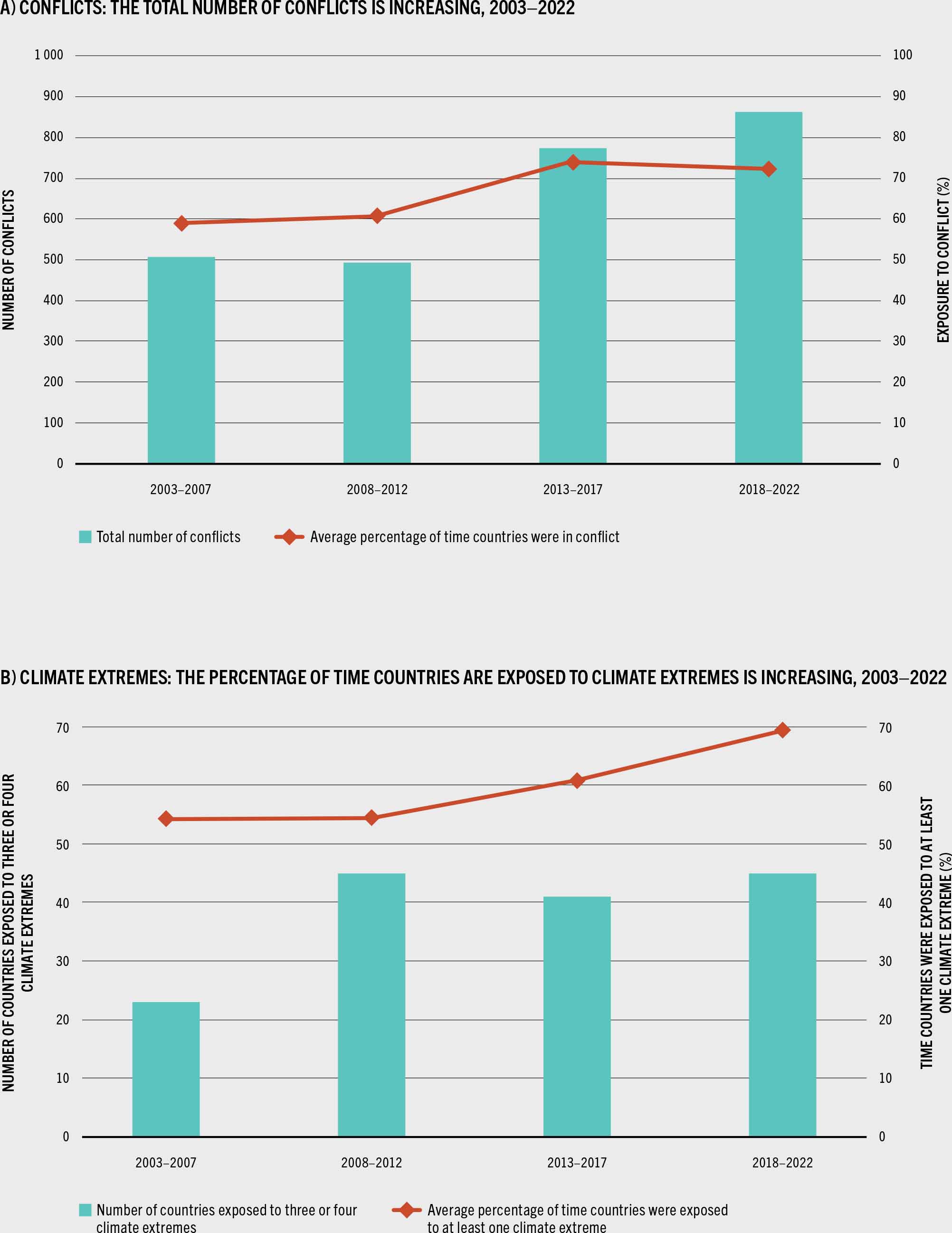
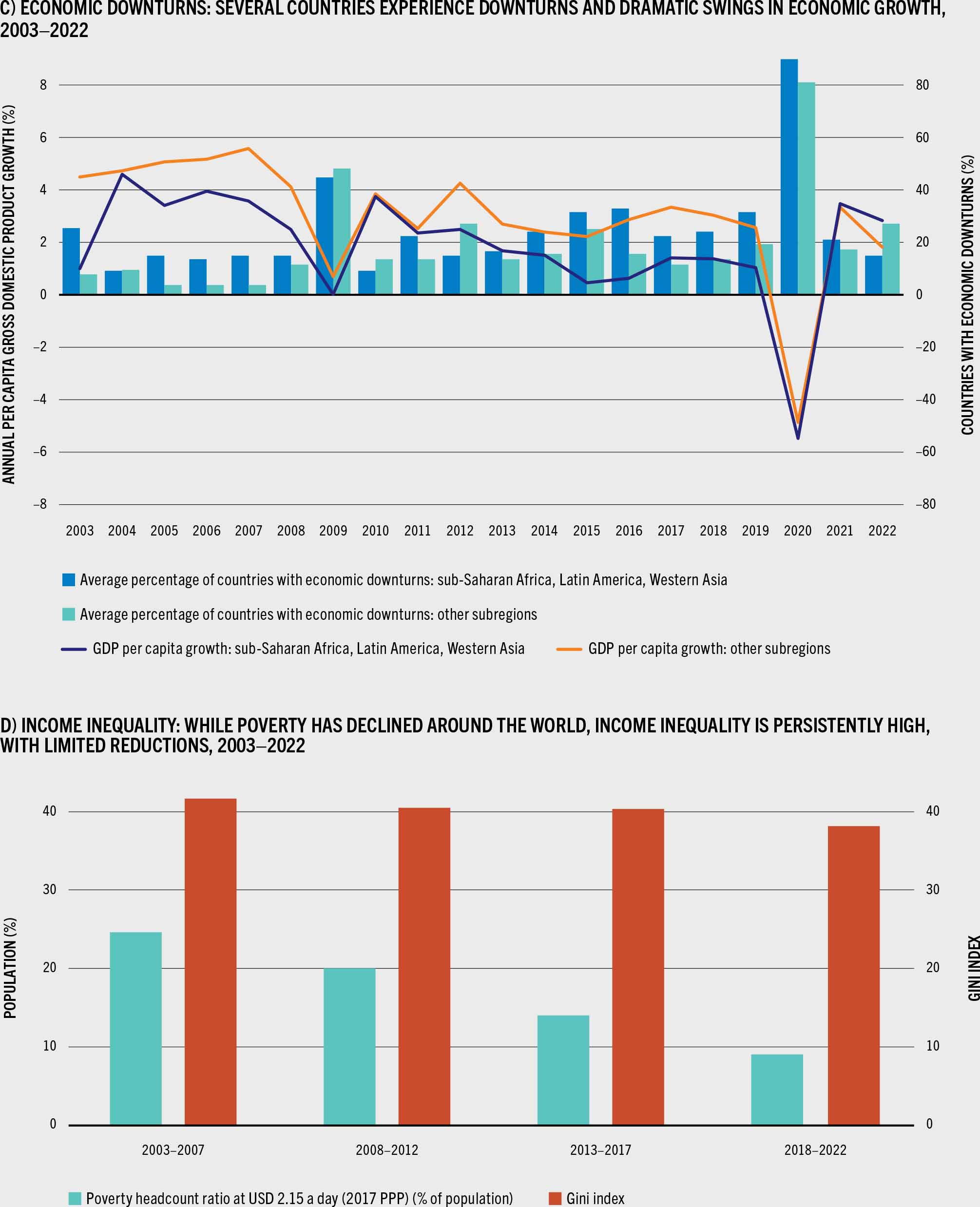
SOURCE: Authors’ (FAO) own elaboration.
The analysis of the countries affected by the major drivers is a key input to generating a framework for innovative financing to scale up support to food security and nutrition, which is presented in Section 5.1. Therefore, the analysis of countries affected by the major drivers is updated for this year’s report. Results are summarized here, while the methodology, data sources and full updated analysis are provided in the Supplementary material to Chapter 3.
The extent to which a major driver negatively affects people’s food security and nutrition depends on their degree of exposure and their vulnerability to its impact. In the analysis, countries are categorized based on whether they are “affected” by a major driver. In summary, two criteria are used for a country to be categorized as being affected by a driver: i) evidence of the occurrence of an event related to the driver in a country, for example, the occurrence of a conflict, a climate extreme, or an economic downturn; and ii) evidence of vulnerability to the impacts of such an event, which refers to conditions that increase the probability that the occurrence of the driver event will negatively affect the country’s food security and nutrition situation (see Supplementary material to Chapter 3, Table S3.5 for methodologies and data sources).
While each of these major drivers is unique, they often interact to create multiple compounding impacts transmitted through agrifood systems to the detriment of food security and nutrition.30 As a result, all dimensions of food security are likely to be affected, including food availability, access, utilization and stability, as well as the other determinants of nutrition, specifically practices (e.g. food preparation and handling, infant and young feeding practices, health-seeking behaviour, intra-household resource allocation, and care for girls and women) and health services and environmental health (e.g. immunization, water and sanitation, and availability and affordability of, and access to health services). For instance, a growing body of literature is also demonstrating the direct impact of climate, particularly extreme heat, on the nutritional status. This is corroborated by the association found between the occurrence of these drivers and the food security and nutrition indicators.30
Alarmingly, the majority of low- and middle-income countries are affected by at least one of the major drivers and, where there are multiple drivers occurring, the compounding impacts lead to the highest increases in hunger and food insecurity (Figure 18). Countries in a protracted major food crisis are severely affected by multiple drivers and face among the highest level of food insecurity (Box 8, Figure A1).
FIGURE 18 Hunger is higher and has increased the most in countries affected by the major drivers, and hunger increases are higher in poor countries affected by more than one major driver

SOURCE: Authors’ (FAO) own elaboration.
BOX 8Protracted major food crisis countries are severely affected by multiple MAJOR drivers and face among the highest levels of chronic food insecurity
The 2024 edition of the Global Report on Food Crises,31 an annual report that provides analysis and evidence on acute food insecurity requiring urgent humanitarian assistance to save lives and livelihoods, identifies 19 protracted major food crisis countries,* of which most are low-income food-deficit countries (14 out of 19). These 19 countries have been in a major food crisis for the past eight years, and six countries (Afghanistan, Democratic Republic of the Congo, Ethiopia, Nigeria, Syrian Arab Republic and Yemen) have consistently ranked among the top ten in terms of the population affected, with 108 million people facing high acute food insecurity (IPC level phase 3 or above) in 2023.31
Based on this report’s analysis,** 18 of the 19 major protracted food crisis countries have data on the prevalence of undernourishment (PoU),*** and all have been affected by at least one major driver of food insecurity, such as conflict, climate extremes or economic downturns, between 2013 and 2022. The only exception is Eswatini, which nevertheless faces high income inequality. Thirteen countries are affected by multiple drivers, a factor that mirrors the extremely high level of PoU observed in 2023 in these countries (Figure A1).
A1) Countries in protracted major food crisis are severely affected by multiple MAJOR drivers and face among the highest prevalence of UNDERNOURISHMENT, 2023
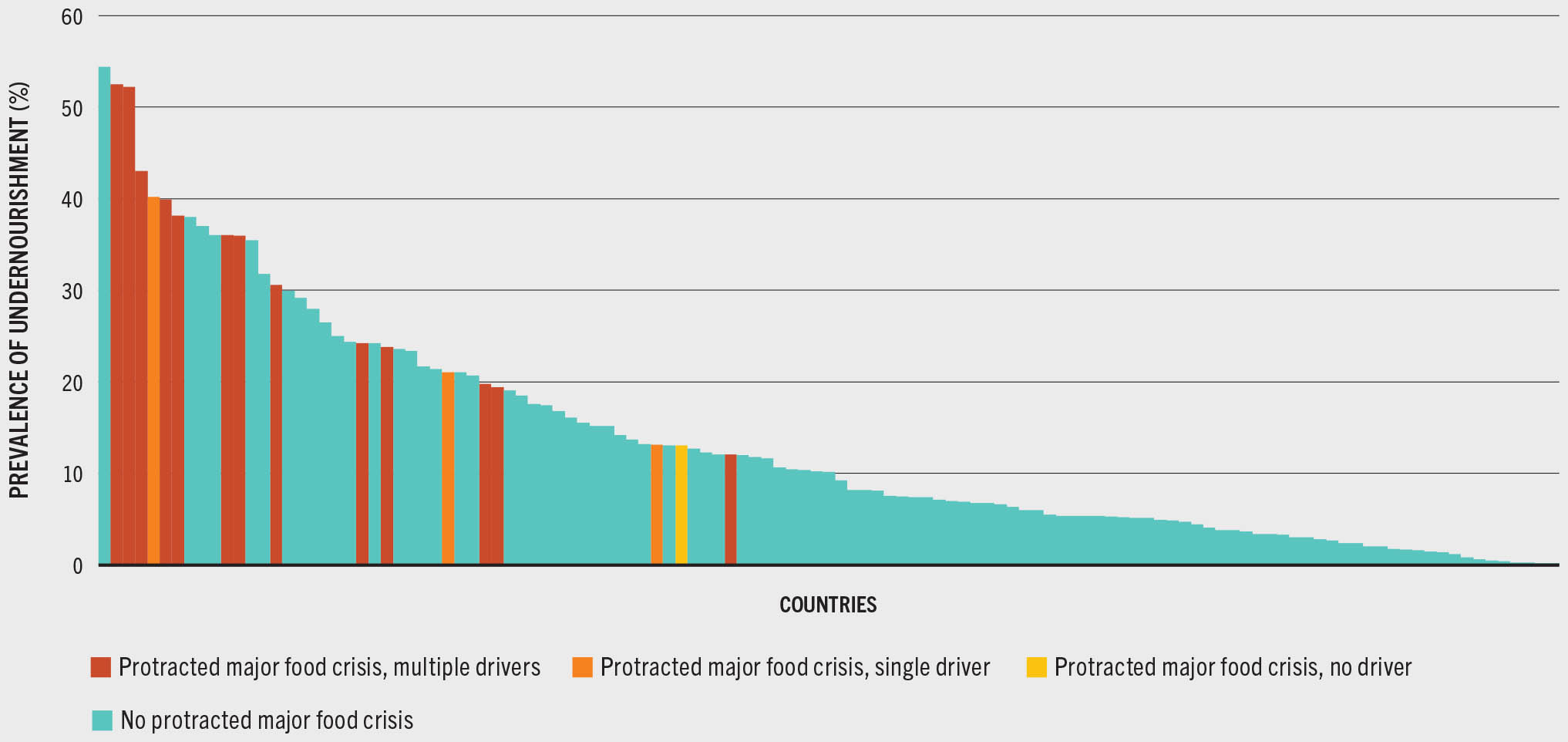
Over the past decade, protracted major food crisis countries have witnessed a steady rise in the PoU, with those affected by climate extremes or economic downturns facing always higher PoU levels (Figure A2). The increase in PoU between 2019 and 2023 was notably sharper in countries affected by economic downturns (Figure A2 and Supplementary material to Chapter 3, Figure S3.6), and it was three times higher in these protracted major food crisis countries compared to the rest of low- and middle-income countries (2.9 percent versus 1.1 percent).
A2) The prevalence of undernourishment has steadily increased since 2013 in protracted major food crisis countries affected by major drivers
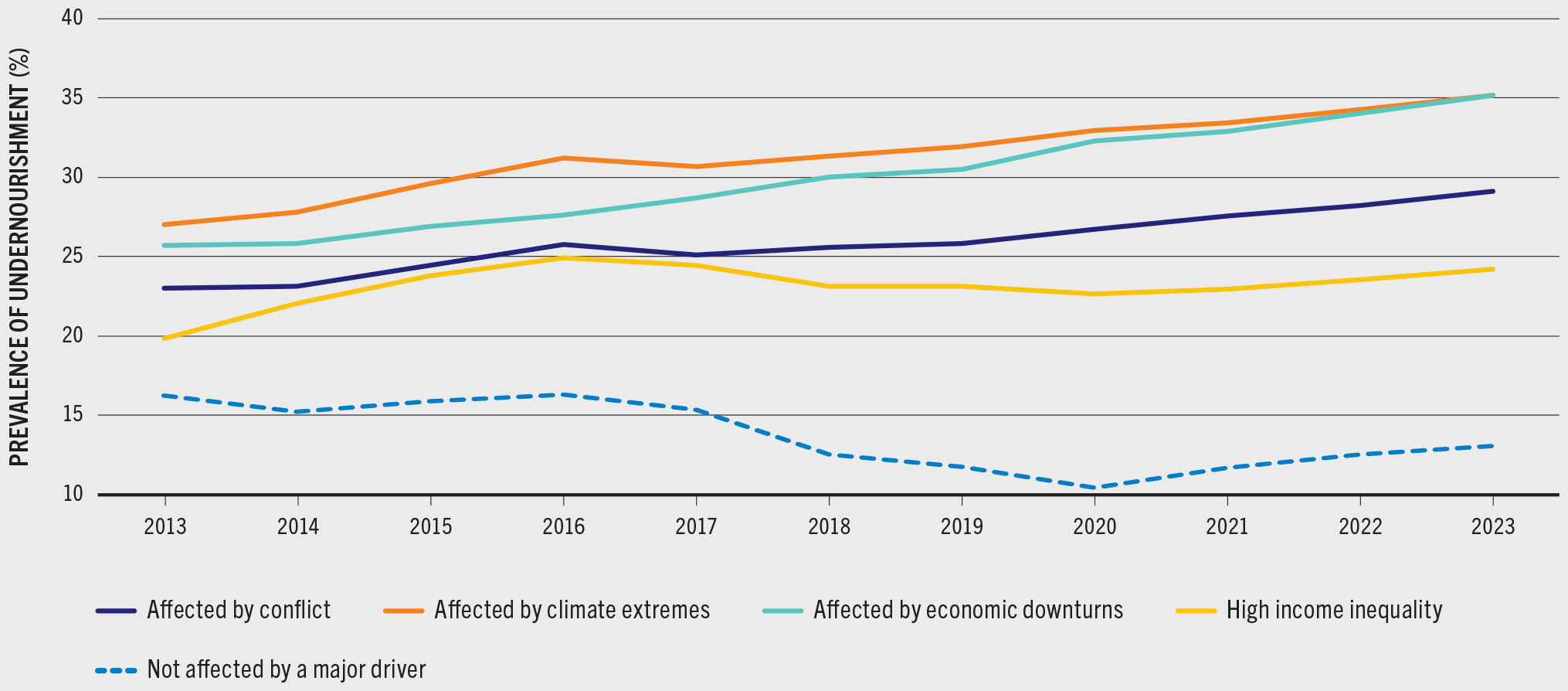
SOURCES: Authors’ (FAO) own elaboration. PoU based on FAO. For list of countries in major food crisis: FSIN (Food Security Information Network) & GNAFC (Global Network Against Food Crises) 2024. Global Report on Food Crises 2024. Rome. https://www.fsinplatform.org/report/global-report-food-crises-2024
The impact of major drivers on chronic hunger, as measured by the PoU, in protracted major food crisis countries cannot be understated. The gap in PoU between countries affected by conflict, economic downturns or climate extremes and those unaffected has widened over time (Figure A2). The compounding effect of multiple drivers results in higher levels of food insecurity. Countries affected by multiple drivers saw the most significant increase in PoU between 2019 and 2023, and countries affected by all three major drivers face the highest overall level of food insecurity (Supplementary material to Chapter 3, Figure S3.5 and Figure S3.6).
Among the 36 countries in protracted food crisis,**** 33 countries had available PoU data. The findings described above hold true also for them. Among protracted food crisis countries, what sets apart countries in a protracted major food crisis is their exposure to multiple drivers: 72 percent of countries (13 out of 18) in a protracted major food crisis are affected by multiple drivers compared with only 27 percent (4 out of 15) in a protracted food crisis. The tangible consequence is a general lower level of PoU for the protracted food crisis countries. Nevertheless, it is countries in protracted food crisis, excluding major crisis, affected by conflict that experienced the highest increase in PoU between 2019 and 2023 (Supplementary material to Chapter 3, Figure S3.7A and Figure S3.7B).
This analysis draws urgency to the call to integrate humanitarian and development approaches and financing in protracted food crisis countries to address immediate emergency acute food insecurity needs, while also addressing chronic food insecurity, including building resilience in agrifood systems to the major drivers and underlying structural factors. For instance, the 2023 Financing Flows and Food Crises Report shows that financing related to the food sector is predominantly humanitarian, while development finance represents only a small share of the financing flows related to the food sector received by protracted food crisis countries.32
** The analysis in this box applies this report’s methodology for countries affected by major drivers as outlined in the Supplementary material to Chapter 3, Table S3.5. While the Global Report on Food Crises identifies drivers of acute food insecurity and there are overlaps on this with this report, the methodology applied to chronic food insecurity measured by the PoU is different.
*** The 19 countries classified as protracted major food crisis countries in the Global Report on Food Crises 202431 are: Afghanistan, Cameroon, Central African Republic, Chad, Democratic Republic of the Congo, Eswatini, Ethiopia, Haiti, Madagascar, Malawi, Mozambique, Niger, Nigeria, Somalia, South Sudan, Sudan, Syrian Arab Republic, Yemen and Zimbabwe. The data series for the PoU for South Sudan is not long enough for the analysis of countries affected by major drivers and is therefore excluded.
**** The 36 countries/territories classified as protracted food crisis countries in the Global Report on Food Crises 202431 are: Afghanistan, Bangladesh, Burkina Faso, Burundi, Cameroon, Central African Republic, Chad, Democratic Republic of the Congo, Eswatini, Ethiopia, Guatemala, Guinea, Haiti, Honduras, Iraq, Kenya, Lesotho, Liberia, Madagascar, Malawi, Mali, Mauritania, Mozambique, Nicaragua, Niger, Nigeria, Senegal, Sierra Leone, Somalia, South Sudan, Sudan, Syrian Arab Republic, Uganda, Yemen, Zambia and Zimbabwe. The data series for the PoU for Burundi, South Sudan, and Lesotho are not available or not long enough for the analysis of countries affected by major drivers and are therefore excluded.
The extended definition of financing for food security and nutrition encapsulates the interventions that contribute to one or more of the six transformative policy pathways proposed in the 2021 edition of this report30 to address the major drivers of the current levels of food insecurity and malnutrition. Each of the six transformative pathways leads to the implementation of policies, investments and legislation to build resilience to each one of these major drivers (Figure 19 and Box 9). In this way, the extended definition builds on the core definition but goes beyond the eradication of hunger, food insecurity and all forms of malnutrition to also address the major drivers.
FIGURE 19 The extended definition of financing for food security and nutrition addresses the major drivers through policies and actions along six transformative pathways
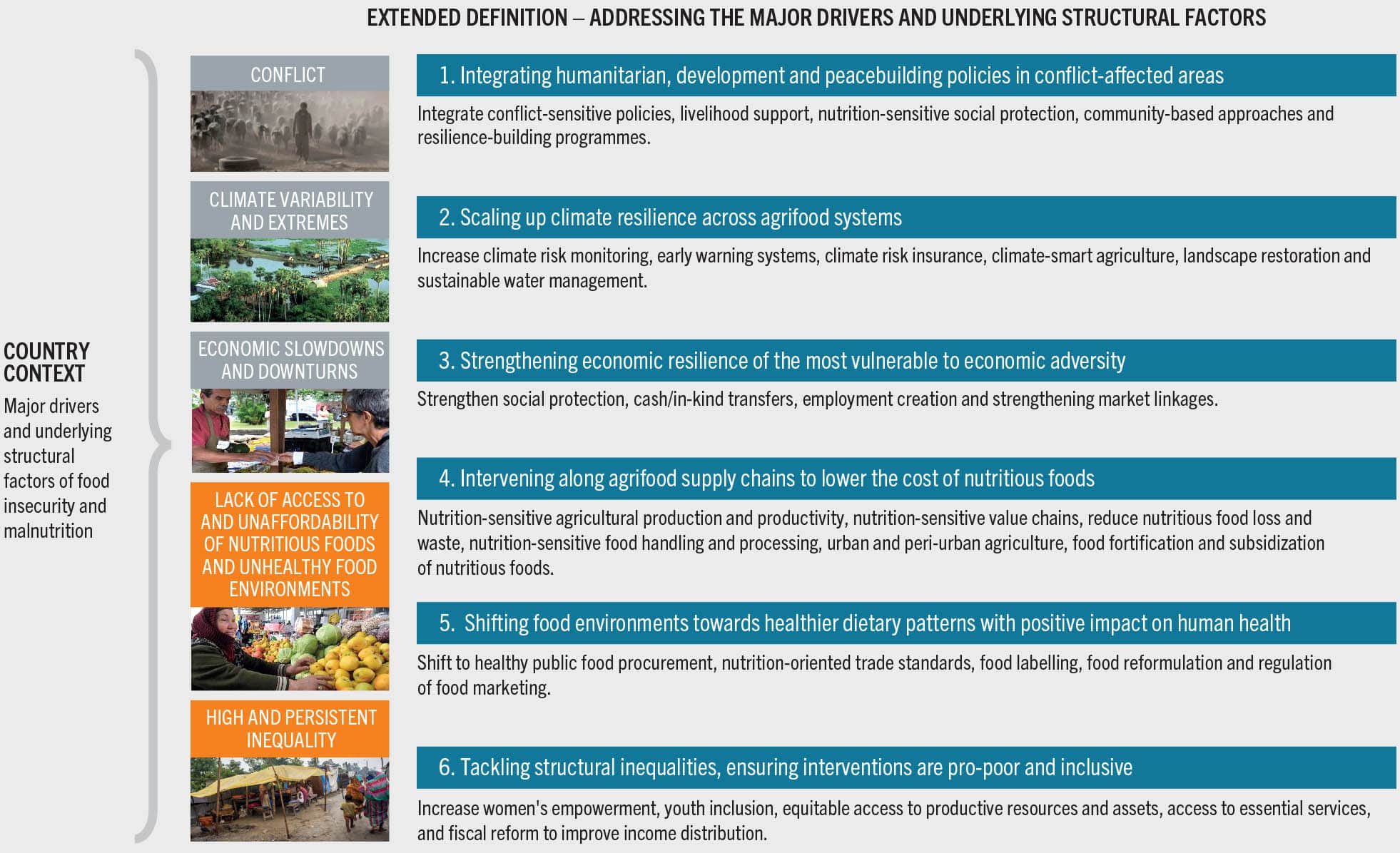
BOX 9Six transformation pathways to address the major drivers of food insecurity and malnutrition
As shown in Figure 19, depending on the driver or combination of drivers confronting a country, there are six transformative pathways that include key policies, actions and investments for building resilience to these major drivers, based on an in-depth analysis and evidence from the 2017–2020 editions of this report.
PATHWAY 1: INTEGRATING HUMANITARIAN, DEVELOPMENT AND PEACEBUILDING POLICIES IN CONFLICT-AFFECTED AREAS
- Promoting conflict-sensitive policies; fostering peacebuilding efforts linked to livelihood support; implementing nutrition-sensitive social protection and food production and supply programmes; supporting functioning and resilient food supply chains; adopting community-based approaches in post-conflict policies.
- For example, in conflict and post-conflict areas, people-centred, negotiated development approaches can also address issues of land access, use and management, which also contribute to peace. The provision of community-based animal health services and livestock vaccinations to the Dinka Ngok and Misseriya communities in the contested Abyei area in South Sudan and the Sudan, working with local government bodies, United Nations peacekeepers and other United Nations entities, was an effective entry point for re-establishing intercommunity dialogue, leading to a local-level peace agreement.
PATHWAY 2: SCALING UP CLIMATE RESILIENCE ACROSS AGRIFOOD SYSTEMS
- Reducing climate-related risks; adapting to climate change; adopting climate risk monitoring and early warning systems; supporting climate risk insurance; promoting improved access to and management of natural productive assets (e.g. landscape restoration, water management); implementing climate-smart interventions.
- For example, in Zambia, new initiatives aimed at raising climate resilience include the introduction of agricultural insurance for vulnerable households. Households that adopt conservation agriculture techniques are provided with access to agricultural insurance, which in turn allows them to invest in riskier projects with potentially higher revenues. Under this approach, agricultural insurance is important not only for building climate resilience but also for supporting poverty reduction and increased food security and reduced malnutrition.30
PATHWAY 3: STRENGTHENING ECONOMIC RESILIENCE OF THE MOST VULNERABLE TO ECONOMIC ADVERSITY
- Strengthening agrifood productivity and market linkages along the food supply chain; curbing rises in food prices and excessive price volatility; boosting decent job creation; expanding social protection schemes and school feeding programmes.
- For example, investments to develop local agro-industrial value chains can open market opportunities for small-scale farmers, reducing their vulnerability to commodity price shocks, especially in export commodity-dependent countries, and increasing their resilience based on diversified economic activities. In Senegal, following a decline in global ground prices, government investments to integrate small-scale producers into profitable and diversified value chains helped farmers transition away from groundnut production by investing in poultry rearing and vegetable growing, which lead to more stable and increased crop incomes.33
PATHWAY 4: INTERVENING ALONG AGRIFOOD SUPPLY CHAINS TO LOWER THE COST OF NUTRITIOUS FOODS
- Increasing investments for nutrition-sensitive agricultural production and productivity; increasing efficiency of nutritious food value chains; reducing nutritious food loss and waste; promoting food biofortification; enacting mandatory food fortification; improving rural roads and infrastructure (e.g. nutritious food storage facilities).
- For example, in Myanmar, small and medium enterprises have received direct transfers, increased access to new technologies and training in sustainable production techniques to diversify food production. More than half of the programme’s participants have seen their incomes increase by 50 percent, while the expansion of their production to include fresh vegetables has significantly increased the supply of nutritious foods in local markets.30
PATHWAY 5: SHIFTING FOOD ENVIRONMENTS TOWARDS HEALTHIER DIETARY PATTERNS WITH POSITIVE IMPACT ON HUMAN HEALTH
- Strengthening food environments (e.g. supporting healthy public food procurement and services); changing consumer behaviour to include sustainability considerations (e.g. improving trade standards with a nutrition-oriented lens, taxing energy-dense foods, introducing legislation on food marketing, food labelling and food reformulation, eliminating industrially produced trans fats).
- For example, in Chile, following the introduction of a law on food labelling and advertising, pre-school children’s and adolescents’ exposure to advertising for foods high in salt, sugars, energy or saturated fats dropped, while the sales of these foods in school food kiosks was banned. Purchases of foods and beverages high in salt, sugars, energy or saturated fats, which were required to carry front-of-pack warning labels, also fell 24 percent following introduction of the regulation.
PATHWAY 6: TACKLING STRUCTURAL INEQUALITIES, ENSURING INTERVENTIONS ARE PRO-POOR AND INCLUSIVE
- Empowering populations in situations of vulnerability and marginalization; reducing gender inequalities by supporting women’s economic activities and the equitable distribution of resources; promoting the inclusion of women, youth and other populations in situations of marginalization; guaranteeing access to essential services; implementing fiscal reforms to reduce income inequality.
- For example, gender inequalities are still persistent across all regions and all country income groups. In Indonesia, a coastal community development project promoted sustainable fishery and aquaculture production practices by providing production inputs and establishing processing facilities and market linkages. Women, who are primarily engaged in fish processing and marketing, saw their empowerment increase by 27 percent, while fish productivity increased by 78 percent and post-harvest losses fell by 5 percent.
SOURCE: Adapted from FAO, IFAD, UNICEF, WFP & WHO. 2021. The State of Food Security and Nutrition in the World 2021. Transforming food systems for food security, improved nutrition and affordable healthy diets for all. Rome, FAO. https://doi.org/10.4060/cb4474en
Mapping and application of the core and extended definitions to financing flows
The application of the core and extended definitions of financing for food security and nutrition is shown in Figure 20. Financing for building resilience to the major drivers of recent increases in food insecurity and malnutrition (extended definition) is additional and complementary to the core definition. Moreover, as the figure shows, the extended definition must consider country context. Not all countries are affected by all the major drivers. While some are affected by a single driver, countries in which food insecurity has increased the most are usually affected by a combination of drivers. This means that, theoretically, countries would not need to fund the adoption of all six transformative pathways, but only those that address the major drivers they are facing, considering the country’s context.
FIGURE 20 Application of the core and extended definitions of financing for food security and nutrition
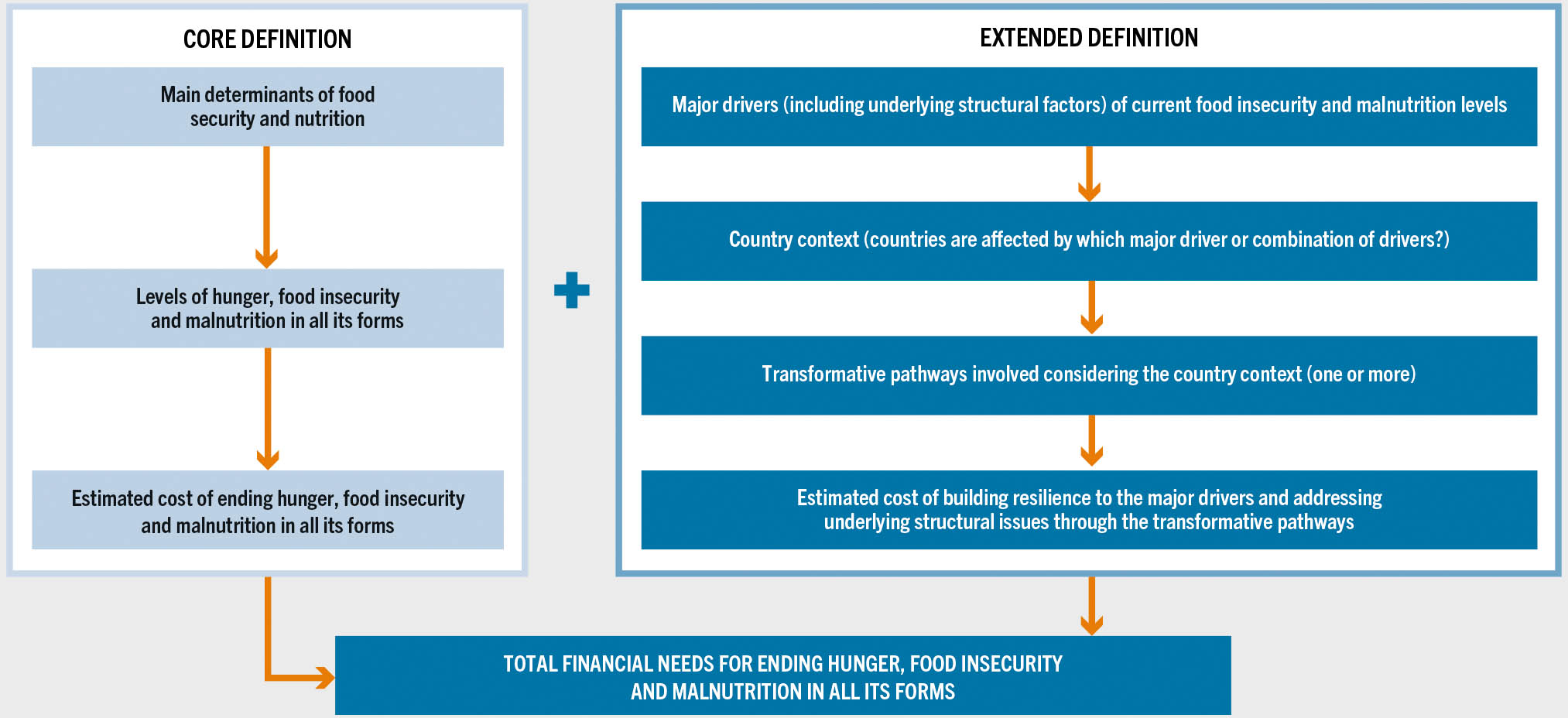
To move from the definition of financing for food security and nutrition to an application of this definition to measure the levels of financing for food security and nutrition requires an understanding of how financing flows are categorized and reported, and then the development of guidelines for mapping these flows to the definition. The conceptual framework around food security and nutrition clearly outlines the different determinants and pathways relevant to meeting SDG Targets 2.1 and 2.2. However, assessing the degree to which the conceptual framework of food security and nutrition can be mapped to financing frameworks and existing databases requires a more granular disaggregation.
For this report, initial mapping and guidance have been developed and applied to arrive at partial estimates of financing for food security and nutrition and their patterns, which are presented in Chapter 4. This mapping consisted of first developing four levels of classification according to the conceptual framework of the core and extended definitions: i) level 1 distinguishes between the core and the extended definition; ii) level 2 between food consumption, health status, and the three major drivers (i.e. conflict, climate variability and extremes, and economic slowdowns and downturns) and the underlying structural factors (i.e. lack of access to and unaffordability of healthy diets and unhealthy food environments, and high and persistent inequality); iii) level 3 between the four dimensions of food security (i.e. availability, access, utilization and stability), practices, and health services and environmental health, and each of the six transformative pathways of policies related to the major drivers; and iv) level 4 between descriptive elements of interventions falling under the level 3 classification. For the full identification of the four classification levels in tabular form, see Table S3.2 in the Supplementary material to Chapter 3.
Second, keywords were identified to clarify the sorts of financing and interventions that were linked to the four-level classification. A more detailed framework was necessary given that some financing and interventions could align with multiple areas of the framework. For example, school feeding is relevant to the core definition, in terms of both food consumption (i.e. food utilization and food consumption behaviour) and health status (i.e. infant and young feeding practices). School feeding is also identified in the extended definition in Pathway 3 on economic slowdowns and downturns. While conceptually this overlap is not necessarily an issue, when mapping the definition of food security and nutrition to data representing financing flows, this could lead to the double counting of resources. To avoid overlaps in assigning financing flows, keywords are identified, and decision rules constructed to guide the allocation across the classification levels. See Table S3.3 for the keywords and Table S3.4 for the decision rules in the Supplementary material to Chapter 3.
Distinguishing financial allocations between “specific” and “supportive” financing for food security and nutrition is important. “Specific” refers to financing that contributes wholly or 100 percent to food security and nutrition. However, as discussed in Section 3.1, there are important financial allocations that contribute to food security and nutrition without exclusively supporting only food security and nutrition outcomes. For these types of “supportive” financing measures – those allocations that only partially contribute to food security and nutrition – a weight is applied to account for the percentage of their contribution to food security and nutrition. The identification and application of weights is fraught with challenges and limitations, due to the lack of data and evidence to establish weights; however, the alternatives – either to disregard supportive expenditures or to include their full amounts in estimates – would present even more limitations. For the methodology, data sources and application of weights, including the limitations, see Section S3.2 and Table S3.3 in the Supplementary material to Chapter 3.
Moving from a definition of financing for food security and nutrition, to mapping it to financial allocations is a challenging task, but one that is necessary, irrespective of what definition is applied. Given that current financing flows and budgets are defined on a sectoral basis, as explained, it is difficult to apply any definition of financing for food security and nutrition, and to do so unavoidably requires making gross assumptions. This is true not only for the new definition presented above, but also for all other financing for food security and nutrition definitions applied in published studies, although this is not always explicitly staged or transparently mentioned. Because financial resources are categorized by sector, there is a risk of “overcounting” or “undercounting” expenditures and investments in support of food security and nutrition and their relative importance.
This report brings transparency to this process, while also providing a new definition of financing for food security and nutrition, and guidance for its application that is more in line with the financing efforts needed to meet SDG Targets 2.1 and 2.2. It is an initial step, going forwards, to take advantage of one definition that should continue to be refined and improved. With this report, the United Nations System and all governments now have an adequate definition and framework for tracking the financing available and needed for food security and nutrition, as part of the means of implementation to meet SDG Targets 2.1 and 2.2. Yet, do data allow us to apply them?
Chapter 4 shows that data to apply the new definition of financing for food security and nutrition exist only for some of the financing flows; hence, it is not possible to take realistic stock of how much financing is available, let alone calculate the financing gap to support efforts to meet SDG Targets 2.1 and 2.2. Therefore, data sources and methodologies must be advanced to ensure there are better data for evidence-based decisions on financing for food security and nutrition. This report, in fact, also sends a loud and clear call for better financial data that can be used for tracking financing for food security and nutrition. Without this, tracking financing for food security and nutrition will remain elusive.
This report thus also calls for universal adoption and transparency in the use of a standardized approach for operationalizing this new definition in its mapping and application to financial data.

